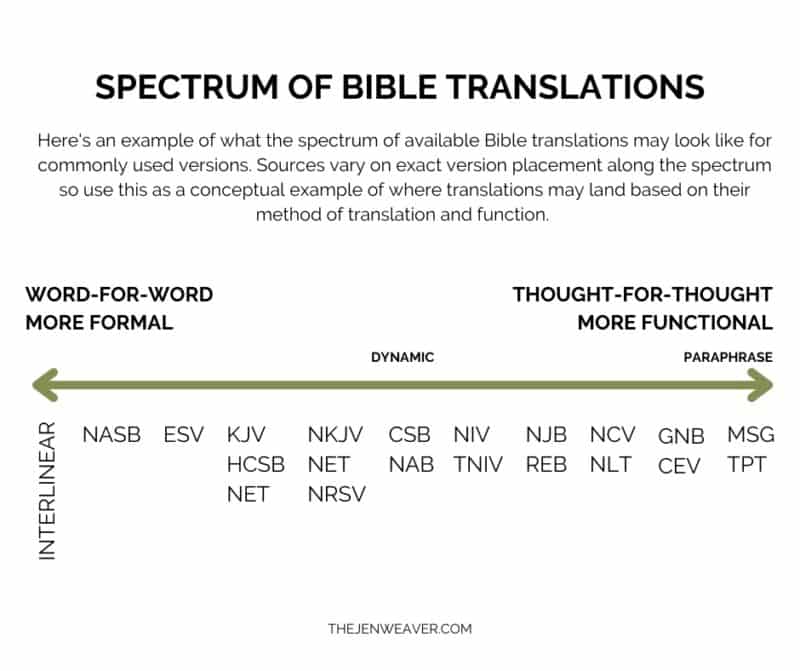Both Bible reading and Bible study are important, and they are different approaches to God’s Word. I like to include regular time for both activities. I often focus on a specific topic or book of the Bible for in-depth study a few times a week, and then spend time in general Bible reading on other days.
Bible Reading: Think Wide
In reading we, read larger chunks of the Bible at a time, looking at big themes as we get familiar with the Bible as a whole and the overall story of God and loving rescue and redemption.
Bible Study: Think Deep
When we study, we zoom in to look at words in their source language, exploring various passages and how they relate to each other, and specific areas of focus and author intent for individual passages and books.
Pick Your Bible Translation Based On Your Purpose
We are RICH with Bible translations and resources to help us connect with God through his word. However, different Bible translations serve different purposes, so you’ll want to be intentional in selecting which Bible you pick up based on the purpose of that time. For example:
- Reading or study? (My favorites are to study from ESV & NKJV and read NLT, NIV, & TPT)
- Memorizing? (I prefer to memorize from ESV)
- Reading with newer believers or kids? (I love reading The Jesus Storybook Bible with my kids which is definitely creative paraphrase and not something we’d memorize from)
Types of Bible Translations

Word-for-Word Translation
Word-for-Word translation (aka formal equivalent or literal translation) seeks to represent the original Greek and Hebrew as much as possible in a more word-for-word manner. These translations aim for original word order, grammar, and syntax. Bibles with this type of translation are most helpful to use in Bible study. Also it’s important to remember that no translation is 100% literal as we move from source language to our language, and are reading text originally written for a different time, culture, and audience.
Interlinear translation is the most accurate as it includes the Hebrew and Greek texts with a direct English rendering below each word.
Dynamic Translation
Dynamic translation (aka mediating translation) is in the middle of the spectrum between Word-for-Word and Thought-for-Thought. These translations try to find a balance between the two approaches, sometimes more literal and other times more conversational.
Thought-for-Thought Translation
Thought-for-Thought translation (aka paraphrase or functional equivalent) seeks to put the meaning or idea of the passage in everyday language familiar to the reader. This translation is often more readable, especially for new readers and can be helpful in Bible reading alongside other Word-for-Word translations.
Paraphrase
When you get to the far side of this spectrum you’re working with more Bible paraphrases, like in the Message or Living Bible. Paraphrases aren’t really translations, but are more restating English translations using different English words. This can be enjoyable for Bible reading as they often use creative and descriptive wording, and can spark different curiosity in familiar passages. You’ll want to be careful to refer back to Word-for-Word translations to understand the intended original meaning and context.
Knowing the Difference Helps Us Know God
Knowing the difference between Bible reading and Bible study helps us approach our times in the word with intentionality. And knowing the difference between different Bible translations helps us select tools based on our purpose for that activity.
We have the Bible as a resource to help us know God more and connect with him. As you spend time in the Word, continue to ask God for wisdom and guidance. That’s a prayer he delights to answer!











